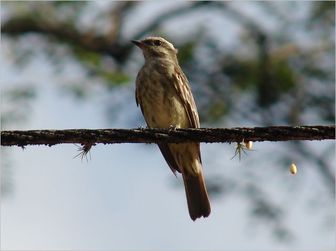Piratic Flycatcher
This tyrant flycatcher is found in savannah and other semi-open habitat with large trees. It gets its name because it does not build its own nest, but appropriates the domed or enclosed nests of other, often far larger, bird species, such as Yellow-rumped Cacique or Crested Oropendola. Once the persistence of the flycatchers has driven the rightful owners away, their eggs are removed, and the female flycatcher lays up to four, but usually two, black-streaked brown eggs. She incubates these on her own for 16 days to hatching, with a further 18-20 days to fledging.

Original source: Dolhijn
Author: Dolhijn
Permission: GNU Free Documentation License
The Piratic Flycatcher is classified as Least Concern. Does not qualify for a more at risk category. Widespread and abundant taxa are included in this category.
A Piratic Flycatcher, Legatus leucopalus, was found by Gene Blacklock on 3 May at Pollywog Pond, Corpus Christi, Nueces County, Texas. There are other records from Texas, New Mexico, and Florida, but see below. On 15 March 1991, a "Variegated Flycatcher" was reported in the Dry Tortugas, Florida. In a subsequent 2004 review, the Records Committee of the Florida Ornithological Society, voted 7-0 in favor of the Variegated Flycatcher being removed from the state list and correctly replaced by Piratic Flycatcher. More
The Piratic Flycatcher, Legatus leucophaius, is a passerine bird, the only member of the genus Legatus. It is a resident breeder from southern Mexico and Trinidad south to Bolivia and Argentina. At least some birds from Central America and Trinidad are migratory, and this species also visits Tobago. This tyrant flycatcher is found in savannah and other semi-open habitat with large trees. More
The Piratic Flycatcher has a large range, estimated globally at 11,000,000 square kilometers. Native to the Central and South America, and Mexico, this bird prefers subtropical or tropical forest ecosystems but can live on arable land or pastureland as well as in degraded former forests. The global population of this bird has not been precisely determined but is quite large and does not show signs of decline that would necessitate inclusion on the IUCN Red List. More
Piratic flycatchers are found from southeast Mexico to northern Argentina. Habitat Piratic flycatchers are found in forest edges, river edges, semi-open country, and in cultivated areas with tall trees. . Diet Piratic flycatchers eat insects and berries. They perch on tree branches and wait for their insect prey to fly by and then fly after it. More
Piratic Flycatcher: Small olive-brown flycatcher has brown crown, white face with dark eye-line and moustache stripe, white throat shading to pale yellow on belly, and faint dark streaks on breast, sides. Dark wings have two bars; pale feather edges. Dark tail has pale feather edges. Range and Habitat Piratic Flycatcher: Breeds from southeast Mexico to northwest Ecuador. Spends winters in South America. Frequents open country with scattered trees and forest edges. More
The adult Piratic Flycatcher is 15 cm long and weighs 23g. The upperparts are unstreaked plain brown, although the flight feathers have narrow white edges. The head has a long whitish supercilium (line above eye), a concealed yellow crown stripe, and a dusky mask through the eyes. The throat is white, and there is a white malar (cheek) stripe. More
Piratic Flycatcher determination Similar species Tyrannidae Amazonian Royal Flycatcher | Bearded Tachuri | Black-capped Becard | Black-chested Tyrant | Black-crowned Tityra | Black-tailed Tityra | Boat-billed Flycatcher | Boat-billed Tody-Tyrant | Bran-coloured Flycatcher | Brown-crested Flycatcher | Cinereous Becard | Cinereous Mourner | Cinnamon Attila | Cinnamon-crested Spadebill | Cliff Flycatcher | Common Tody-Flycatcher | Double-banded Pygmy-tyrant | Drab Water-Tyrant More
According to Morton, the Piratic Flycatcher can feed very fast because it eats unripened fruit. They also prey on insects, mainly dragonflies, waiting on exposed tree limbs till they notice prey, then flying out to attack. They feed insects to their young. Family - Flycatchers Other Name - Black-banded Petchary Latin Name - Legatus leucophaius Range - From Mexico south to Argentina including Trinidad TR-PF01-04-04. More
Less than a half-dozen Piratic Flycatchers have been noticed in the United States. The species is named for a pair's propensity to dive at birds of another species to pirate active nests that aren't open at the top (e.g., pendant nests). Adults subsist mainly on fruit but feed arthropods to their nestlings for protein. picture not ready yet ManyBirds Bird Videos Home + TIPS for watching these video clips at a computer... More
This Piratic Flycatcher Legatus leucophaius - found by Gene Blacklock the day before -was photographed at Pollywog Pond, Corpus Christi, Nueces County, Texas on May 04, 2008; separation of Piratic Flycatcher (PIRFL) from Variegated Flycatcher (VARFL) is an issue since a handful of each taxon have been documented in Canada and the U.S. (c. 5 VARFL; c. More
to record a piratic flycatcher for their lifelists. The next day was an odd one for me as the office was closed for major plumbing repairs. My normal practice is to hit the gym after morning Mass and then return to the office, but on this day that wouldn't be the case. More
Family : Tyrannidae
Genus : Legatus
Species : leucophaius
Authority : (Vieillot, 1818)
